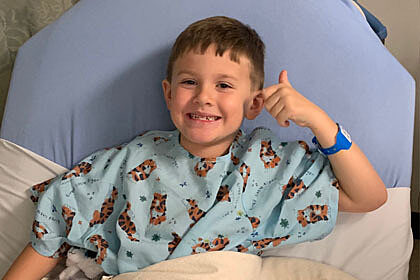Traveling for Kidney Care: Baylor’s Journey
Baylor Bennett was born with a blockage in his kidneys. His parents were told that he would grow out of it, and for six years, he had no symptoms. Then, one…

Update your location to show providers, locations, and services closest to you.
Since 1990, laparoscopic and more recently robotic surgery has become main stream as minimally invasive surgical alternatives for many urologic conditions including both benign and cancerous conditions.


UF Health Shands Hospital is rated High Performing for urologic care by U.S. News & World Report.
In most cases, laparoscopic and robotic surgery has resulted in:
Laparoscopic surgery allows a surgeon to perform complex procedures within the abdomen without having to place his hands directly into the body cavity. This is achieved by using miniaturized instruments placed through portals, called trocars, inserted through keyhole size incisions made in the abdomen. The abdominal cavity is inflated with carbon dioxide gas to provide a working space for the surgeon to operate in. Visualization of the internal anatomy is provided by a high definition, digital camera attached to a telescope lens inserted through one of the trocar sites. As the incision size tends to be smaller than for open surgery, postoperative pain is reduced in addition to blood loss and transfusions.
More recently, robotic surgery, introduced into the field of urology in 2000 has gradually supplanted many of the laparoscopic procedures due to advancements in visualization, ergonomics and instrumentation. Robotic surgery using the da Vinci™ Surgical Robotic System provides distinct advantages over conventional laparoscopic surgery. First, improved optical technology provides surgeons with not only a high definition, 10-12 X magnified view but also more specifically a three dimensional depth perception of the internal anatomy as compared to the two dimensional view offered by laparoscopic surgery. Second instead of the rigid instruments used during laparoscopic surgery, advancements in multi-jointed robotic instruments allows the surgeon to operate with the same ergonomic freedom as using his hands and wrists thus providing greater range of motion of instrumentation. Third, motion scaling technology allows for reduction in tremor and highly precise surgical dissection during robotic surgery.
UF Health Urology surgeons have a cumulative experience of over 800 robotic surgeries including prostatectomy, radical and partial nephrectomy, pyeloplasty, adrenalectomy, nephroureterectomy, vasectomy reversal, and spermatic cord neurolysis. To view a comprehensive listing of all laparoscopic and robotic procedures performed by our surgeons, please visit the individual webpages listed below.

 UF Health Shands Hospital is ranked among the top urology programs in the nation and is ranked in the highest category for prostate cancer surgery by U.S. News & World Report.
UF Health Shands Hospital is ranked among the top urology programs in the nation and is ranked in the highest category for prostate cancer surgery by U.S. News & World Report.
Since 1990, laparoscopic and more recently robotic surgery has become main stream as minimally invasive surgical alternatives for many urologic conditions including both benign and cancerous conditions.
In most cases, laparoscopic and robotic surgery has resulted in:Baylor Bennett was born with a blockage in his kidneys. His parents were told that he would grow out of it, and for six years, he had no symptoms. Then, one…

For Courtney Munroe, lightning struck twice in the form of cancer. But when Courtney was diagnosed with prostate cancer and then kidney cancer, he didn’t have…
